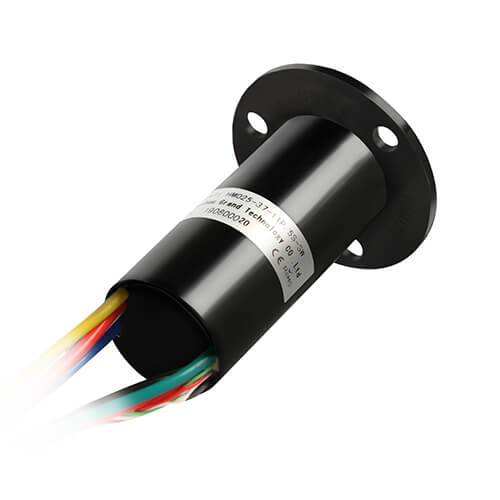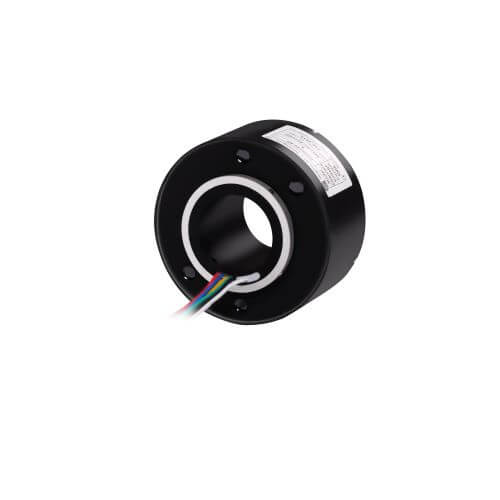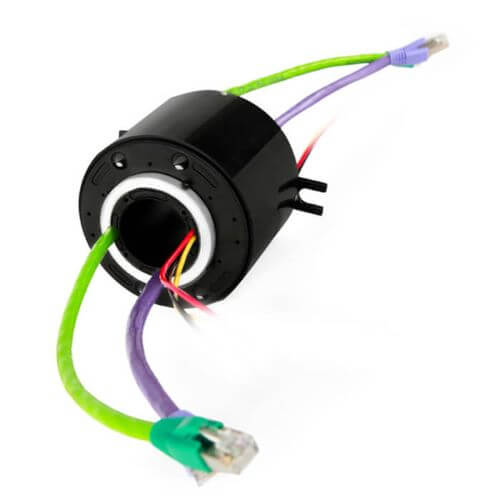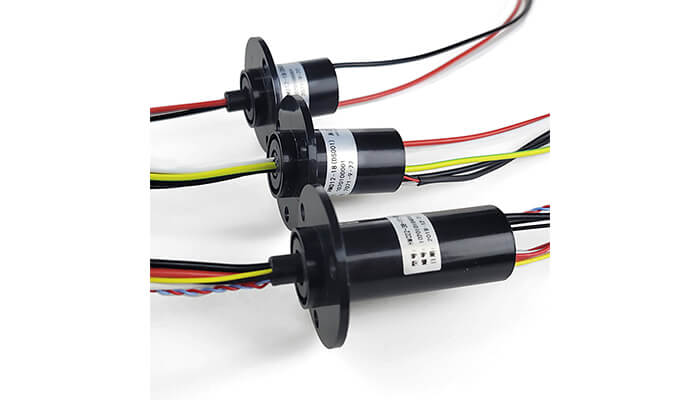In the realm of electrical engineering, slip rings serve as key components that enable the continuous transmission of power and signals between stationary and rotating parts within various systems. Be it in wind turbines, automotive alternators, or advanced robotic arms, the importance of these rings to the function and efficiency of these systems is paramount. This comprehensive guide will delve into the intricacies of slip rings, their design considerations, instances of their application in different scenarios, potential pitfalls to avoid during design and selection, and the importance of understanding interaction with other components and environmental factors to their performance.
Introduction to Slip Ring Design
Electrical machines, ranging from wind turbines to industrial equipment, and beyond, incorporate a crucial component in their operations – a slip ring. This guide aims to provide comprehensive information about the intricacies of slip ring design, shedding light on their fundamental principles and best practices.

Importance of Optimal Slip Ring Design
Slip rings play a pivotal role in the smooth operation of many rotating machines used daily in various sectors like renewable energy, defense, and industrial automation. These devices allow for the transfer of power or signals between stationary and rotating parts of the equipment. The optimal slip ring design is critical. Because even minor interruptions or inefficiencies in this power transfer can lead to significant operational problems.
The slip ring design impacts the service longevity of the equipment, maintenance requirements, and overall system reliability. A poorly designed slip ring can lead to several issues, including noise, signal interruption, data loss, and even the detriment of the entire system. On the other hand, an optimized design ensures efficient and continuous performance, longer service life, and less maintenance, promoting machine uptime and productivity.
Basic Components and Functionality of a Slip Ring
A slip ring, often referred to as a rotary electrical joint, electrical collector, or swivel, is an electromechanical device that allows the transmission of power and electrical signals from a stationary to a rotating structure. This function is vital in systems where constant rotation prohibits direct connection via wires.
The primary components of a typical slip ring are the rotating and stationary parts. The rotating part called the rotor, is connected to the machine’s moving section. It usually carries the electrical loads and signals. The stationary part, known as the stator, connects to the stationary power and signal sources. To manage the connection between the stator and the rotor, a crucial interface is designed, consisting of conductive rings and brushes.
The conductive rings are secured on the rotor, and the brushes, made from a highly conductive material such as copper or precious metals, are mounted on the stator. As the rotor turns, the brushes maintain contact with the rotating rings, ensuring uninterrupted power and signal transmission throughout the rotation cycle.
Understanding these fundamental components and their functionality serves as a solid foundation on which to delve deeper into the complex world of slip ring design. Optimizing the interaction of these parts will ensure the best performance of your rotating machines and equipment.
With this understanding, we will further guide you through more detailed aspects of slip ring design, its importance, crucial considerations, and how your careful selection can considerably enhance the performance and longevity of your equipment.
Fundamentals of Slip Ring Design
Principles of Electrical Contact
The essence of the slip ring function lies in the electrical contact between stationary brushes and the rotating ring. Quality contact ensures smooth, interruption-free power and signal transfer. To optimize this electrical contact, it’s crucial to find the right balance between brush pressure and the surface quality of the rings. Too much pressure can cause excessive wear, while too little can lead to unreliable contact leading to a loss in signal or power.
The quality of contact, however, is not just reliant on physical attributes. Electron transfer at a microscopic level also plays a crucial role. The rate of electron transfer should be high enough to provide an efficient energy exchange, ensuring maximum conductivity and minimum resistance.
Material Selection and Its Effect on Performance
The choice of materials used in a slip ring’s construction significantly impacts its performance. Different metals exhibit variable conductivities, which directly influence power transfer efficiency. Precious metals like gold, silver, and bronze are often used for brushes and rings due to their superior conductivity and resistance to corrosion.
However, factors like cost, environment, and application-specific requirements also come into play. For example, in high-power applications, materials with better thermal characteristics may be preferred, while in environments where harsh conditions exist, materials with robust resistance to corrosion or wear may be necessary.
Insulation and Separation Material Considerations
Insulation is a vital component in a slip ring to prevent electrical leakages and cross-contacts between conductive paths. The quality and choice of insulation materials can influence the slip ring’s longevity. The insulation material should ideally have high dielectric strength, heat resistance, and mechanical stability.
Separation materials for keeping different circuits apart within a slip ring must also be carefully selected. A failure in this separation can lead to short circuits, which can render the entire machine inoperable. The separation material should be capable of withstanding the highest voltage your application may encounter.
Durability and Life Cycle Considerations
The operational life of a slip ring relies heavily on its design and material selection. By considering the life cycle, engineers can predict when maintenance or replacement would be needed. Factors affecting durability include the wear rate of brushes and rings, environmental impact (temperature, humidity, contamination), rotational speed, and the load carried. By optimizing these factors, the durability and life cycle of a slip ring can be significantly improved.
Size, Weight, and Mounting Considerations
The footprint of a slip ring relates to the space it occupies in an application. Its size and weight should be minimized while ensuring performance isn’t compromised. This is especially critical in applications like aircraft systems, where both space and weight are premium.
Regarding mounting, the slip ring’s design should cater to the ease of assembly and disassembly, replacement of worn-out parts, and adequate support to withstand forces created by the rotating equipment without affecting contact quality.
Speed and Performance Constraints
The performance of a slip ring declines as the rotational speed increases. At higher speeds, maintaining continuous electrical contact becomes a challenge, which can lead to data loss and power surges. It’s imperative to design a slip ring by considering both the highest and lowest speed ranges of the intended application.
Each of the above fundamentals helps shape the design and operation of a slip ring. Understanding and implementing these considerations ensure the creation of a slip ring that certifies both the functional needs and the constraints dictated by the exact application it is meant to serve.
Understanding Different Types of Slip Rings
Just as there are many applications for these essential devices, there are several types of slip rings to accommodate those various needs. Here’s a deeper look at some of the most common designs.
Capsule Slip Rings
Capsule slip rings, named after their compact, cylindrical shape, are designed for transmitting analog and digital signals. They are often used in systems where space is limited but an efficient transfer of data and power is necessary. The key advantage of capsule slip rings is their small size and lightness, making them ideal for use in compact electrical devices like cameras and missile guidance systems.

Pancake Slip Rings
Pancake slip rings have a unique flat disc shape, with concentric rings routed on a flat plane. The main advantage of pancake slip rings is that they provide larger surface contact, offering better performance. Their flat form factor is useful in applications where height is a constraint. However, they typically have a shorter lifespan and a slower speed due to larger brush wear and friction. Application examples include rotary tables and radar systems.

Through-Bore Slip Rings
Through-bore slip rings, as the name suggests, feature a hole in the center. The hole (or bore) can be used to mount the slip ring on a shaft, or for routing fluid lines, other shafts, or the machine’s pneumatic or hydraulic lines. These are commonly used in devices where a clear center is needed, such as large industrial machinery or wind turbines.

Ethernet Slip Rings
Ethernet slip rings are designed with signal integrity in mind. High-speed data transmission applications that operate over Ethernet need slip rings that don’t interfere with the signal quality. These slip rings often feature shielding against noise interference to prevent data loss or degradation. They are commonly deployed in communication equipment, rotating antennas, and other high-speed data transmission systems.

Typical Applications for Each Type
Each type of slip ring finds relevance and optimal performance in different applications:
- Capsule Slip Rings: Considered best for equipment like CCTV cameras, medical systems, and rotating displays due to their compact nature.
- Pancake Slip Rings: Ideal for use in rotary tables, and radar systems where available height space is limited.
- Through-Bore Slip Rings: Predominantly used in heavy rotational devices like wind turbines, military equipment, and large industrial rotary machines.
- Ethernet Slip Rings: Stand out in high-speed communication devices, ethernet communication systems, and rotating antennas where high-quality data transmission is paramount.
By understanding the characteristic strengths and weaknesses of each type of slip ring, you can select the slip ring that fits best with your specific application requirements.
Special Design Considerations
While the standard slip ring design considerations are essential, there are additional special design elements to think about under certain specific situations or requirements. These factors can significantly influence the performance and resilience of the slip ring’s performance.
Working in High Temperatures or High Humidity Environments
Slip rings operating in high-temperature or high-humidity environments must be designed with materials that can withstand these conditions. Special coatings or platings may be needed to prevent corrosion or heat damage. In high-temperature environments, insulation materials with high-temperature ratings should be used. For humidity, water-resistant seals and ventilation to prevent condensation might be necessary.
Designing for High-Speed Data Transfer
When it comes to high-speed data transfer applications, slip rings require precise construction to maintain signal integrity. The materials used, track design, shielding, and grounding all contribute to the performance. Balance between the rotational forces and brush stability is also vital as any unstable contact with the ring can disrupt data transmission.
Shock and Vibration Resistance
Slip rings used in locations prone to shock or heavy vibration, such as military vehicles or industrial equipment, need special design considerations for resilience. The materials used should be more rigid, and the construction might require more secure mechanical fastenings. It’s also essential to ensure that even under such conditions, electrical connections are consistent and reliable.
Packaging and Integration With Other Parts of the System
The packaging must not only protect the slip ring from environmental factors but also facilitate its integration with the rest of the system. It needs to fit within the available space and physically connect with other components—ideally without requiring substantial modifications. Sometimes, the use of specialized connectors eases the integration process.
Customization Possibilities and Limits
The possibility of customization provides flexibility in adopting slip rings for specific applications. While it’s possible to custom fit things like size, number of circuits, means of installation, and more, there are limits depending on the type of slip ring and its fundamental structure. Understanding these limitations during the design phase prevents project delays and redesigns later on.
These special design considerations take into account some of the more extreme or unique scenarios in which slip rings can be used. Understanding them helps ensure that the chosen or designed slip ring will perform optimally—no matter the situation it’s put in.
Steps to Choose and Design a Slip Ring
The design and selection of slip rings is a process that should be carried out carefully. Here are five key steps to guide you through this process:
Identify the Application and Environment of Use
First and foremost, determine the specific application and the environment in which the slip ring will be used. This will provide the context needed to move forward with the design and selection process. Consider factors such as space constraints, equipment type, and any unique factors of the application.
Determine Electrical and Mechanical Requirements
Different applications will have varying electrical and mechanical requirements. Analyze the power transmission needs, signal types, and the number of channels (circuits) that the slip ring needs to support. Address torque requirements, rotational speeds, and any mechanical support, or hardware needed for installation.
Outline Environmental Factors and Operational Speed
Environmental factors such as temperature, humidity, exposure to contaminants, and vibrations or shock should be considered. Determine the operational speed of the slip ring and ensure it remains compatible with these factors. These considerations will impact slip ring material selection and design elements for optimal performance.
Select Appropriate Materials and Insulation
The selection of materials is crucial for the slip ring’s performance, durability, and longevity. This includes conductive elements like brushes and rings, as well as insulation and separation materials. The chosen materials should do well under specific environmental factors and offer the electrical and mechanical characteristics required for the given application.
Define Maintenance and Lifespan Requirements
Estimate the expected lifespan of the slip ring by considering factors such as wear, environmental degradation, and load. Plan for the required maintenance schedule, including brush replacement and ring cleaning. Determine if any components need easy access for periodic checks or replacements. This is essential to ensure the slip ring operates as intended and prevents unanticipated downtime.
By following these steps to choose and design a slip ring, you will be able to develop or select a device that meets your needs and performs efficiently and reliably within the intended application and environment.
Factors Affecting Overall Slip Ring Performance
The overall performance of any slip ring system wildly depends on several factors. Identifying these factors and understanding how they might affect system performance can be crucial in optimizing the slip ring’s effectiveness and lifespan.
Noise Reduction Techniques
Electrical noise can cause erroneous readings or improper functioning of the attached equipment. Different noise reduction techniques like shielding, improved grounding, the use of filters, or compliant circuit design can minimize these interferences. Such noise reduction features can significantly improve the performance, especially in slip rings used in sensitive signal transmission.
Dealing with Wear and Tear
Wear and tear is a natural process for slip rings due to their inherent design. Brushes rubbing against the ring cause wear that may lead to deteriorating performance over time. Regular maintenance, use of wear-resistant materials, and optimized design can slow down wear and tear. The addition of advanced materials that offer self-lubrication, like certain graphite or metal alloys, can dramatically improve lifespan.
Ensuring Smooth Electrical Transmission
Consistent and smooth electrical transmission significantly affects the overall performance of the slip ring system. It depends on the quality of materials, design precision, and efficacy of the maintenance routine. Erratic contact between the brush and the ring should be minimized. Ensuring the suitable spring pressure for brushes, smooth surface of conductive rings, and proper cleaning can all contribute to smoother electrical transmissions.
Heat Dissipation Techniques
The heat produced due to friction or electricity conduction can impact the slip ring’s performance. If not dissipated correctly, heat can deform components, cause materials to degrade, and affect electrical properties. Implementing effective heat dissipation techniques like using thermally conductive materials, incorporating cooling systems, and ensuring proper ventilation can improve the device’s performance and increase its lifespan.
Dealing with Challenges in High-Speed Signal Transmission
High-speed signal transmission presents several challenges, including maintaining signal integrity, dealing with electromagnetic interference, and managing rapid heat generation. These issues can be dealt with through adequate shielding, carefully chosen materials, advanced circuit design, and proper heat dissipation measures.
In summary, several factors can affect the overall performance of a slip ring. Recognizing these factors and mitigating any negative impact through engineering techniques can ensure that a slip ring performs reliably and effectively over its intended lifespan.
Case Studies on Slip Ring Design
To better understand the process of slip ring design and selection, let’s examine two case study examples. These illustrate how the process might differ depending on the application’s specific requirements.
Designing a Slip Ring for A Wind Turbine
A wind turbine uses a slip ring to transmit electrical power from the rotating blades to the non-rotating nacelle. The specific needs for a wind turbine application might include:
- High Current Capacity: A wind turbine generates a significant amount of power, which means the slip ring must handle high currents.
- Environmental Resistance: Wind turbines operate in outdoor environments exposed to weather, high winds, and temperature variants – all of which must be considered in the design.
- Long Lifespan: Given the difficulty in accessing a wind turbine for maintenance, it’s vital to choose durable materials and a design that minimizes wear and tear.
- Through-Bore Design: Wind turbines often require a through-bore design to allow cables to pass through the center of the slip ring.
Designing a Slip Ring for A Robotic Arm
A robotic arm may use a slip ring to provide power and control signals across its rotating joints. The specific needs for a robotic arm application might include:
- Compact Size: As a robot arm may have space limitations, a compact, lightweight slip ring is preferable.
- Transmission of High-Speed Data and Signals: To allow quick response times and accurate movements, the slip ring should enable high-speed data and signal transmission.
- Low Electrical Noise: Given the sensitivity of control signals for a robotic arm, the slip ring design should incorporate features to minimize electrical noise.
- Resistance to Vibration: Robotic arms are often exposed to high vibration, so a slip ring designed for operation in such conditions is beneficial.
Challenges and Solutions in Each Case
Wind Turbine Application:
One significant challenge is designing a slip ring that can operate reliably in vast outdoor environments, where weather conditions can fluctuate wildly. This can be achieved by using materials that resist corrosion and wear, can endure a broad temperature range, and provide sufficient sealing to prevent water and dust ingress.
Robotic Arm Application:
The main challenge here is ensuring smooth, uninterruptable data and signal transmission in a compact package. A solution might involve using specialized techniques and materials that reduce electrical noise and accommodate high-speed data transmission. Vibration resistance can be enhanced by securing the mechanical parts of the slip ring more firmly and choosing materials with higher rigidity.

In conclusion, these case studies illustrate that designing an efficient slip ring requires a comprehensive understanding of the application’s unique requirements and challenges and the willingness to customize to meet these needs.
Pitfalls to Avoid in Slip Ring Design and Selection
While designing or selecting a slip ring, it’s vital to avoid some common pitfalls that might lead to system failures or inefficiencies. Understanding these mistakes can help ensure that your slip ring functions effectively in its intended application.
Common Mistakes in the Design and Selection Process
- Overlooking Application Specifics: Inadequate consideration of the specific application and operating environment of the slip ring can lead to poor performance or premature failure.
- Neglecting Maintenance Needs: Not considering or planning for the necessary maintenance can result in unexpected downtimes and a shorter lifespan for the slip ring.
- Miscalculating Material Choices: Improper choice of materials—for both the electrical and mechanical components—can result in insufficient durability or electrical performance.
- Ignoring Thermal Management: Negligence regarding heat dissipation can cause parts to degrade or malfunction due to excess heat generated during operation.
- Overloading the System: Designing the slip ring for a lower capacity than what it will be subjected to could result in system failure.
- Forgetting about Standard Compliance: Not adhering to related industry standards or regulatory requirements can lead to safety issues and non-compliance penalties.
Tips to Avoid These Mistakes
- Detailed Requirement Analysis: Always start with a comprehensive understanding of your application, operating environment, and electrical and mechanical requirements before beginning your design or selection process.
- Define a Maintenance Routine: Ensure easy access to the necessary parts for maintenance and plan a proper routine to preserve optimal performance over time.
- Material Selection: Ensure the materials chosen for both electrical and mechanical components are suitable for the intended application and operating conditions.
- Thermal Management: Adequately factor in techniques for heat dissipation within the design or selection of the slip ring to prevent overheating.
- Consider Load Capacities: Keep safety margins in mind and avoid running the system constantly at its maximum load to maintain system longevity and reliability.
- Adhere to Standards: Ensure the selected or designed slip ring complies with necessary industry standards or regulations.
In conclusion, it’s vital to have a well-informed, planned approach when designing or selecting a slip ring. Avoiding the common pitfalls can lead to improved system performance, reliability, and a successful project outcome.
Conclusion
Slip rings play a critical role in electrical systems by facilitating power and signal transmission between stationary and rotating components. To optimize slip rings for specific applications, it’s essential to consider factors such as noise reduction, wear and tear, smooth electrical transmission, heat dissipation, and high-speed signal transmission. Practical examples, like wind turbines and robotic arms, highlight the importance of understanding the unique needs of intended applications. To ensure the efficient and reliable operation of slip rings, it’s crucial to be aware of and avoid common pitfalls in their design and selection, while adhering to relevant industry standards and regulations.
See What We Can Do

